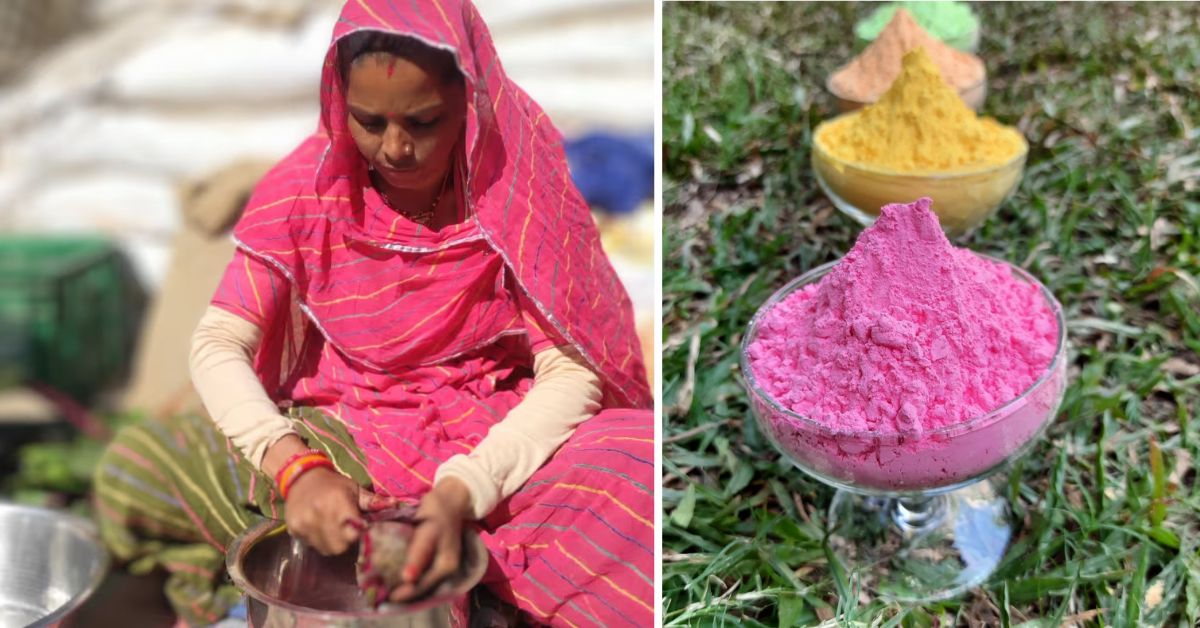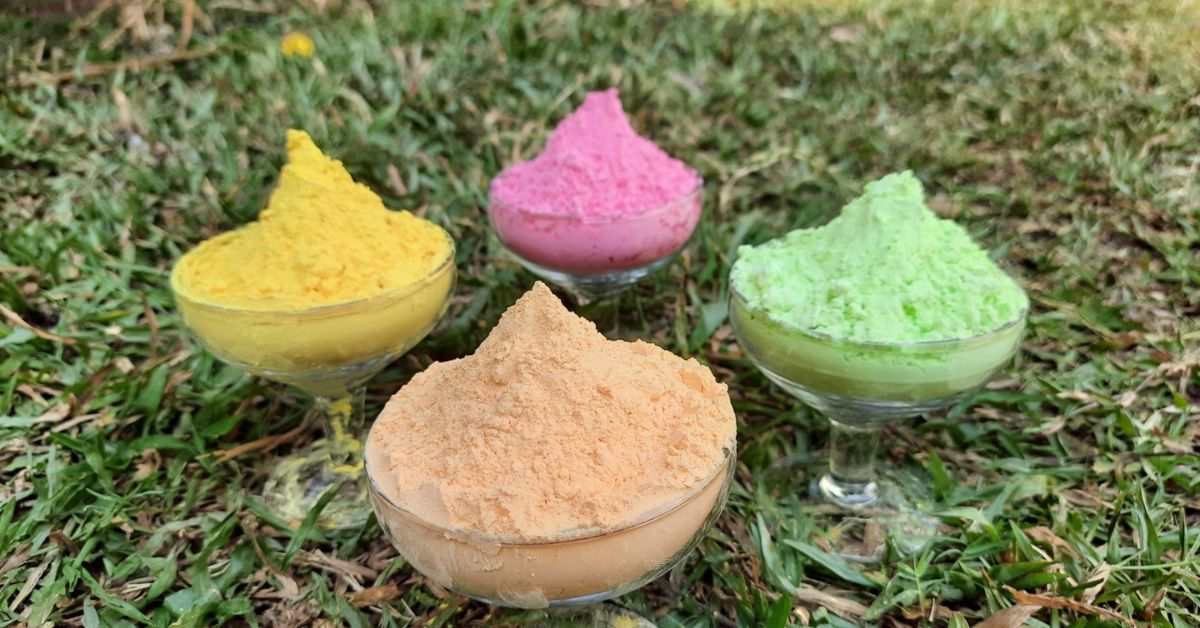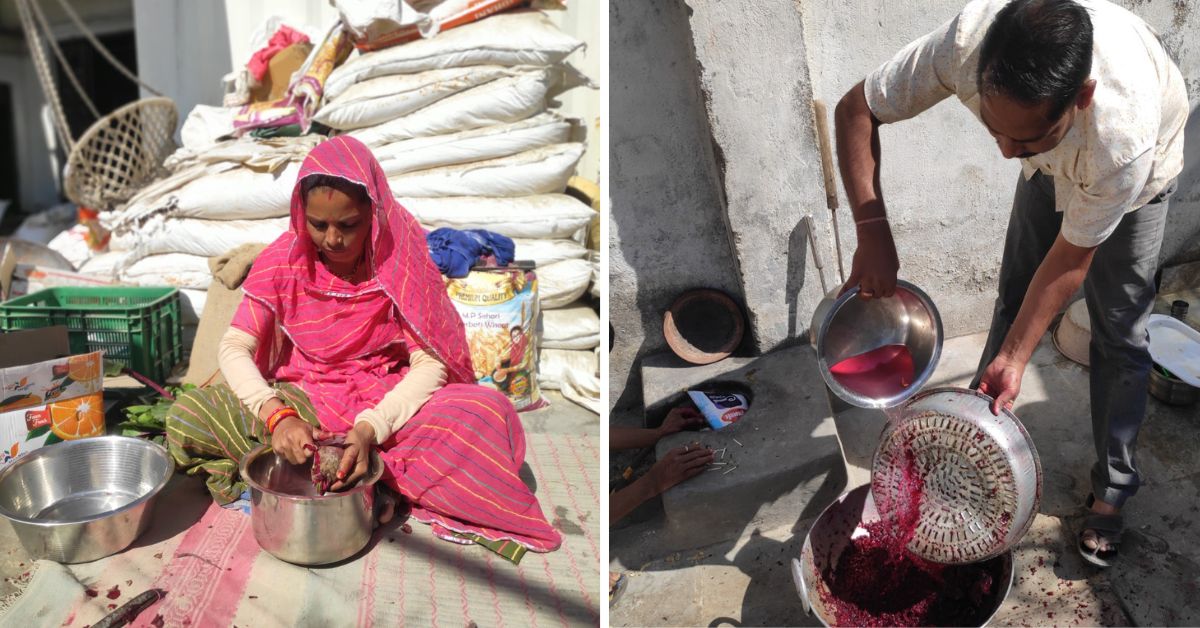This Holi, Play With 100% Edible & Organic Colours Handcrafted By Bhil Tribals
Brothers Gaurang and Saurabh Motta launched 'Abeer’ with the aim to save Bhil tribe’s dying art of making natural Holi colours using flowers.

Holi is almost here, ready to paint the country with its exquisite hues. The exuberant festival brings many delights with it like the delicious food, drinks and traditions – and an underlying worry about the quality and impact of the colours used to celebrate the festival as well.
These synthetic colours pose harm not only to your skin and body but also to the environment. The chemicals used to prepare them can seep into the ground, pollute water sources, and contribute to air pollution.
To tackle this problem, two brothers from Mumbai, who have dedicated close to a decade to natural conservation, came up with a solution. Gaurang and Saurabh Motta started ‘Abeer Holi Colours’, a brand under ‘Monks Bouffe’, an organic food and farming brand which sells everything from organically grown rice, maize, natural Holi colours, among others.
These colours, crafted by the Bhil tribe using flowers and no other additives, are not only natural but also edible!
“Yes, you can eat them,” Gaurang emphasised when I, perplexed by their claim, questioned them again. “The colours are not only edible but also safe for the environment, skin, and animals. We wanted to preserve the tribe’s dying art by giving it a platform,” he explained to The Better India.

‘The turning point’
Gaurang and Saurabh had flourishing careers in the finance and the IT sector, respectively. “We had always been very environmentally conscious,” Gaurang states.
However, this consciousness evolved into a desire to take macro-level actions when the duo began volunteering at a Mumbai-based NGO.
“We met the founder of the NGO, Julius, who left us inspired by the work he was doing, and soon we became friends. He was involved in conservation efforts of the tribal parts of Maharashtra,” Gaurang recalls.
“As we visited rural areas to meet the tribals striving to become more eco-conscious and even transition to organic farming, we discovered they faced challenges with the supply chain and reaching the right consumers,” he adds.
This realisation sparked an idea in the brothers. They decided to transition to this sector and assist the tribal communities.
“We thought we would have our own farm but decided against it as we felt that the community needed our help more,” he says.
While the brothers were very sure of their idea, their friends and family were a little sceptical. “This was something which was not the plan of our family for us. It became very difficult for them to understand the need for such a shift. Additionally, back when we started in 2016, the idea of organic farming, the conservation of native trees was not very popular,” he says.
“But we had an urge to go for it anyway. In 2016, we decided to start ‘Monk Bouffe’ with the aim of bringing tribal produce to the right buyers, and have never looked back,” he adds.
Natural, organic and edible Holi colours
During one of their conservation efforts across the tribal areas in Maharashtra, Rajasthan and Chattisgarh, the duo encountered people from the Bhil community.
“This community, based on the outskirts of Udaipur, Rajasthan, consists of a small number of members. Among other skills, they possess an incredible talent for handcrafting natural colours,” Gaurang explains.
Unfortunately, the community’s skill was dwindling due to the prevalence of synthetic colours in the markets.

“Not much attention was paid to the community anyway, but what truly saddened us was witnessing the dying art without recognition. The community used handpicked flowers to create natural colours devoid of adulterants, a practice passed down through generations. It was imperative for us to help preserve it. The younger generation of the tribe showed little interest in learning the art since it didn’t provide monetary gains,” he elaborates.
Determined to salvage the art, the brothers initiated an annual project of producing Holi colours with the tribe and selling them.
“The concept of natural colours was gaining traction at the time. We first launched the Holi colours in 2018 and have been receiving more orders ever since,” Gaurang notes.
Explaining the colour-making process, Gaurang adds, “The colours are entirely natural and made from edible materials. The base is maize flour cultivated by the community itself. The orange colour is derived from the Palash flower, abundant in the area during March and April. Our yellow hue combines Palash flowers with a touch of turmeric.”
Green hues are concocted from a blend of various forest leaves. “Lastly, we have a pink shade crafted using Ganganagri Rose along with a hint of dried beetroot, which enhances the vibrancy,” he adds.
The flowers are first picked, sorted and cleaned. The ingredients are boiled for 14-15 minutes and then they are sieved to segregate the residue. Once this is done, the mixture is dried and then hand-pounded. This is then added to the organic maize flour to make natural colours.
The company primarily serves customers in Maharashtra with a few others from different parts of the country, along with numerous wholesale partners who sell these products as well. “We retail through our website and Amazon,” Gaurang mentions.

This year, the company has already sold over four tonnes of colours!
Jatin Desai, a repeat customer, attests, “This is my second year purchasing the product. The colours are skin-friendly and breathable, leaving no long-lasting skin discolouration. They can be easily washed off on the same day, with only minimal residual tint.”
While the company’s consumer base continues to expand, Gaurang emphasises that the community remains their top priority. “Our primary objective has always been to prioritise the community and their needs. This art has been a part of our country for generations, and it must be preserved. Why resort to chemical and synthetic alternatives when we have perfectly natural and traditional products available?” he asserts. If you found our stories insightful, informative, or even just enjoyable, we invite you to consider making a voluntary payment to support the work we do at The Better India. Your contribution helps us continue producing quality content that educates, inspires, and drives positive change. Choose one of the payment options below for your contribution- By paying for the stories you value, you directly contribute to sustaining our efforts focused on making a difference in the world. Together, let’s ensure that impactful stories continue to be told and shared, enriching lives and communities alike. Thank you for your support. Here are some frequently asked questions you might find helpful to know why you are contributing?

You can buy your packs of organic colour here.
(Edited by Padmashree Pande; All Pictures Credit: Monks Bouffe)
This story made me
-
97
-
121
-
89
-
167













